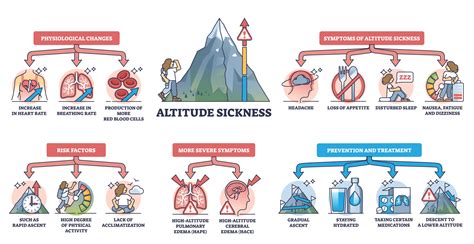Intro
Beat altitude sickness with 5 expert tips, preventing acute mountain sickness, and promoting high-altitude acclimatization, trekking safety, and mountain travel wellness.
Altitude sickness, also known as acute mountain sickness, is a condition that can occur when the body cannot adapt to high elevations, resulting in a range of symptoms from mild to severe. As people travel to higher altitudes for recreational or professional purposes, understanding altitude sickness is crucial for preventing and managing its effects. Whether you're a seasoned adventurer or a novice traveler, being aware of the risks and taking necessary precautions can make a significant difference in your experience. With the right knowledge and preparation, you can minimize the risks associated with altitude sickness and enjoy your time at high elevations.
The importance of understanding altitude sickness cannot be overstated. Every year, thousands of people are affected by this condition, and in severe cases, it can be life-threatening. By learning about the causes, symptoms, and prevention strategies, you can take control of your health and well-being when traveling to high-altitude destinations. Moreover, being aware of the risks and taking necessary precautions can also help you make the most of your trip, allowing you to enjoy the breathtaking scenery and exciting activities that high-altitude destinations have to offer.
As you prepare for your high-altitude adventure, it's essential to consider the potential risks and challenges associated with altitude sickness. From understanding the symptoms and causes to learning about prevention strategies and treatment options, there's a lot to cover. In this article, we'll delve into the world of altitude sickness, providing you with the knowledge and insights you need to stay safe and healthy at high elevations. Whether you're planning a hiking trip to the Himalayas or a skiing vacation in the Rockies, this article will serve as your comprehensive guide to navigating the challenges of altitude sickness.
Understanding Altitude Sickness

Symptoms of Altitude Sickness
The symptoms of altitude sickness can vary from person to person, but common symptoms include: * Headaches * Fatigue * Nausea and vomiting * Dizziness and lightheadedness * Shortness of breath * Insomnia It's essential to recognize these symptoms early on, as they can worsen over time if left untreated.Prevention Strategies

Acclimatization
Acclimatization is the process of allowing your body to adapt to the high altitude. This can be achieved by ascending to higher altitudes gradually, allowing your body to adapt to the changing air pressure and oxygen levels. Acclimatization can take several days, and it's essential to be patient and not rush the process.Treatment Options

Emergency Situations
In severe cases of altitude sickness, emergency situations can arise. It's essential to be aware of the risks and take necessary precautions to prevent emergency situations. If you experience severe symptoms, such as confusion, difficulty breathing, or chest pain, seek medical attention immediately.High-Altitude Destinations

Planning Your Trip
Planning your trip to a high-altitude destination requires careful consideration of the risks associated with altitude sickness. Here are some tips to consider: * Research your destination: Research your destination and understand the risks associated with altitude sickness. * Plan your itinerary: Plan your itinerary carefully, allowing for gradual ascent and rest days. * Pack essential gear: Pack essential gear, such as a first aid kit, oxygen tank, and warm clothing. * Stay informed: Stay informed about weather conditions and potential hazards, such as avalanches and landslides.Conclusion and Next Steps

We invite you to share your experiences and tips for managing altitude sickness in the comments below. If you have any questions or concerns, please don't hesitate to ask. Additionally, we encourage you to share this article with friends and family who may be planning a high-altitude adventure. By sharing your knowledge and experiences, you can help others stay safe and healthy at high elevations.
What is altitude sickness?
+Altitude sickness, also known as acute mountain sickness, is a condition that can occur when the body cannot adapt to high elevations, resulting in a range of symptoms from mild to severe.
How can I prevent altitude sickness?
+Preventing altitude sickness requires a combination of proper planning, gradual ascent, and awareness of the risks. Gradual ascent, staying hydrated, avoiding strenuous activities, and monitoring your body for symptoms can help prevent altitude sickness.
What are the symptoms of altitude sickness?
+The symptoms of altitude sickness can vary from person to person, but common symptoms include headaches, fatigue, nausea and vomiting, dizziness and lightheadedness, shortness of breath, and insomnia.
How can I treat altitude sickness?
+Treatment options for altitude sickness may include descending to a lower altitude, oxygen therapy, and medications. It's essential to seek medical attention immediately if you experience severe symptoms.
What are some popular high-altitude destinations?
+Popular high-altitude destinations include Mount Everest, Nepal, Mount Kilimanjaro, Tanzania, Machu Picchu, Peru, Rocky Mountain National Park, USA, and the Swiss Alps, Switzerland.
